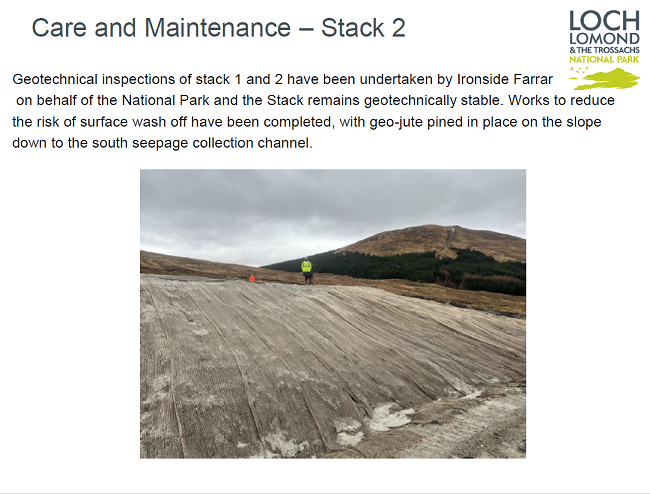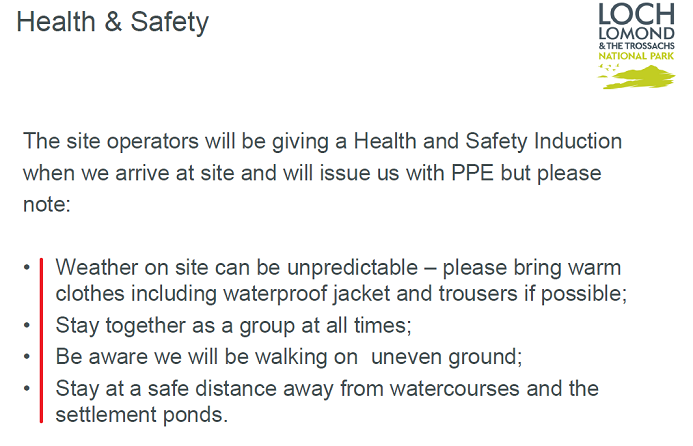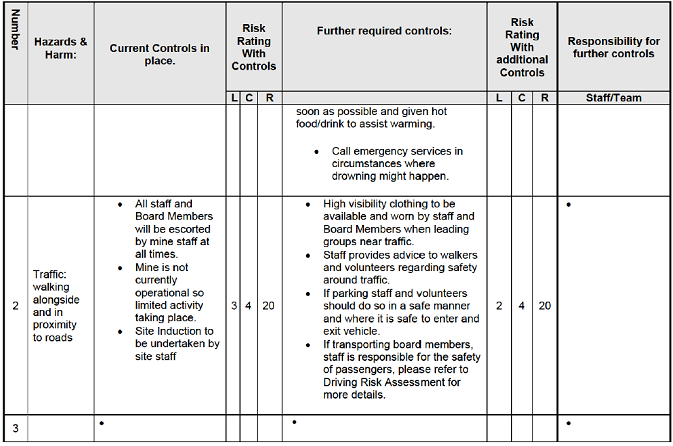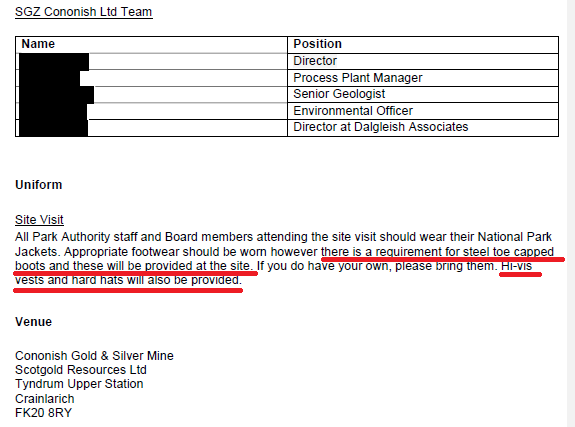
Background
The matters arising paper for the June meeting of the Loch Lomond and Trossachs National Park Authority (LLTNPA) recorded that an ACTION recored in the minute the March meeting, that “SM to look at possibility of organising a site visit to the gold and silver mine at Cononish for Members”, was “closed”. The wording begs some questions? Why would SM, Stuart Mearns the Director of Development, need to look into the possibility of a board visit to Cononish? Do he and his staff, who are meant to be monitoring the now closed mine, have to ask permission from SGZ Cononish, the company that still runs the mine, each time they visit? Why could he have not just said “yes”, of course I will arrange that? And the statement the ACTION was closed could mean anything! I therefore submitted a Freedom of Information on 9th June asking if the board had visited the goldmine and, if so, for any information relating to it.
A visit six months too late
It turns out the out the following board members visited on 27th May: Heather Reid (Convener, who is yet to respond to a single one of my emails expressing concerning about the mine); Rhona Brock; Claire Chapman (Convener of Planning); Maurice Corry; • Martin Earl; Ronnie Erskine (Convener of Audit and Risk Management); Richard Johnston; David Mackie; Shonny Paterson; William Sinclair and Chris Spray along with the following National Park staff: Stuart Mearns, Director of Place; Anna MacLean, Director of Engagement and Innovation; Development Management Planner; and Ecologist.
Given this level of interest, the question arises why these board members did not ask to visit the mine last October, when I first started to alert them to the environmental risks posed by the financial collapse at the mine (see here)? Or last December, when a series of predictable pollution incidents forced planning staff to take action (see here)? In all I wrote to the Convener of the LLTNPA on 11 occasions between October and the end of February, trying to make her aware of the crisis at the mine, and never received any acknowledgment or response from her. A visit any time during that period would have been more than justified but she and her fellow board members chose to leave it until after the crisis was over and, as photos from the FOI show, the mine had been all cleared up so there was very little to see!.

It is possible that some board members wanted to use the visit on 27th May to promote some “learning after the event” but there are no “lessons learned” included in the information response.
Staff control all LLTNPA board members do and say
The majority of information provided in the information response was not about what had gone wrong at the mine last year and had belatedly prompted the visit. Instead, it mainly consisted of instructions to board members of what they could and could not do starting with this letter:

I am not going to publish the whole risk assessment that board members were asked by return to confirm they had read because I have been provided with 30 pages of it but here is a flavour:

It would not be unreasonable to expect that anyone appointed to the LLTNPA board would have experience of being outdoors in National Parks and not need to be told about hazards like uneven ground, sunburn or dehyrdation. So why require board members to read about this?
The LLTNPA never used to do this. I, with a couple of other objectors, were allowed to observe the then LLTNPA Board when they visited the Cononish gold mine site prior to determining the planning application and I do not recall any of this bureaucracy (the risk assessment is for planning visits, not mines as such) or having to sign anything. We were even given a lift up the mine in National Park vehicles and some of the board members spoke to us (without of course saying how they were going to vote). The mine has already been operational, so it was a mine site.
And then, as if this reading the risk was enough, the lecturing was repeated in the slides.

If any LLTNPA Board Member needs to be told that the weather in upland areas like Cononish can be unpredictale, they shouldn’t be on the board. But to dismiss the slides and risk assessment as patronising or nonsensical bureaucracy is, I believe, to miss the point.

By treating board members like very young children you control them, hence “All staff and board members will be escorted by mine staff at all times”. There is not a single hazard mentioned in the risk assessment that you might not come across anywhere in the countryside and nothing specific to the mine and mining. Unless the mine site still contains hidden horrors, e.g polluted land that might poison visitors, there was no justification for trying to control board members in this way.

Forcing board members to wear National Park jackets, Hi Viz Jackets on top of those and steel capped boots to boot, on a site which is non-operatonal and where the public are denied access goes beyond control, its abusive. That is the point, any board member who accepted this level of co-ercion and control by LLTNPA and Cononish staff as normal, was never going to question them.
Despite this exercise in group control, however, it appears LLTNPA senior management were still concerned that some board members could try and hold Scotgold to account. Why otherwise produce this slide?

My guess is that it was aimed at the local Board Member for Balloch, Sid Perrie, who is the one member of the National Park Authority prepared to speak his mind and whom the Board Convener, Heather Reid, threatened to evict from the last meeting for questioning what the proposed changes to the Code of Conduct were really about (see here). While Mr Perrie did not attend the visit, he was one of those scheduled to attend – perhaps the slide made him decide it would be a waste of time? Whatever the case, the slide helps confirm that the primary intention of staff in putting a revised Code of Conduct to the June Board Meeting was to use it to limt critical questions about the planning system, not just at Flamingo Land but Cononish too.
Where now for the Cononish goldmine?
The LLTNPA only published the mine monitoring report for December, which I obtained through an FOI request and discussed in a post in May (see here), in June and has not yet published subsequent reports. Despite the lack of public information, however, I am pretty confident the mine site no longer poses any immediate environmental risk: staff would never have allowed the board to visit if it did.
The main issue now, therefore, is what happens to what is effectively a mothballed mine. There have been no updates to the information about SGZ Cononish, the company that was operating the mine, since Nathaniel Le Roux, the person who now appears to own the mine (see link above), resigned as a Director in January. What if any discussions have taken place between LLTNPA staff and Mr Le Roux and his agents is not public knowledge.
Under the Section 75 Agreement which was put in place for Cononish, the LLTNPA should trigger provisions to restore the site if the mine ceases to operate for a year. With the mine closing at the end of September 2023 that date is only six weeks away. While one of the slides for the board visit referred to the restoration bond and there is a reference to the mine being in a “care and maintenance phase”, nowhere was there any mention of the potential closure of the mine or what happens next.
There is evidence to suggest LLTNPA senior management are putting the interests of Mr Le Roux before those of the National Park. For example, apart from the very belated work to prevent environmental pollution, the LLTNPA appears to have done nothing to resolve the retrospective application (see here) to retain “containers for accommodating site office, welfare facilities and laboratory (including associated infrastructure) and formation of associated parking areas” where there has where there has been no progress since May 2023.
The risk is that if left to staff the LLTNPA will continue to allow the mine to lie in limbo, despoiling the landscape and impact on the public’s enjoyment of it, until “market conditions” are such that Mr Le Roux or someone else can raise funds to start mining again. Such an outcome would be contrary to the intention of the Section 75 agreement and the aims of the National Park which is why the future of the mine needs to be on the agenda of the September Board Meeting and discussed in public.

You really need to get out into the commercial world if you think that risk assessment is anything even slightly unusual. I work for a small ecological consultancy and there risk assement is very similar. Another global consultancy we regularly work with has even mote over the top risk assessments. It’s as much about companies covering their ass legally as it is the individuals H & S.
To be fair this level of risk assessment is now common amongst public bodies in Scotland – it appears to have grown over the last five years or so – and no doubt comes from the centre.
While the Cononish Mine is under a “care and maintenance” regime, the site remains a work site and is regulated accordingly. The operator has fulfilled their obligations under The Management of Health and Safety at Work Regulations 1999 and ensured that the visitors understood the risk assessment and the associated mitigations. The operators are absolutely correct to insist that visitors wore appropriate PPE while on site. This is absolutely standard procedure on any construction, civil engineering, mine or quarry site in the UK
The one thing it is absolutely not is “abusive”, but is simply the application of the H&S legislation
Sure, health and safety rules around mines need to be observed, but that should not be complicated for a visit to a mine above ground when it is not operational. If the slides and other information had only showed a short health and safety briefing I would never have commented. The point of the post was to argue that health and safety is being used for other purposes. I appreciate I did not publish the whole risk assessment but as I stated its for visits to PLANNING SITES which include greenfield sites. It will be interesting to see if the LLTNPA Board have to wear hard hats and hi viz jackets when they wander round Balloch before determining the Flamingo Land planning application!
A good piece, Nick. As always, thanks for shedding a little light on this and other issues affecting our environment.
Why wouldn’t they be expected to wear PPE??? It’s standard practice everywhere!! You’ve clearly got a bee in your bonnet about the mine site as all you do is try and pick flaws and criticise the place.
Another article full of lies as usual from yourself making the place out to be some environmental ticking time bomb.
So what do you think the risks were which would have been mitigated by PPE? There is nothing in the risk assessment which says, because of X risk, Y equipment needs be used. And Where in the article did I say this was an environmental ticking time bomb? The whole point of the post was to explain how the Board wasonly taken to view the site AFTER most of the environmental risks, which were really real (evidenced by SEPA), were had been cleared up. There are actually longer term risks at the mine site , which might well be a ticking time bomb, which I have referred to in other posts and that is polluted mine water. Large sumes of public money are now being spent in England clearing up such water to prevent it working its way into river systems. We do not know how far that is a risk at Cononish because its not been properly considered but my undertstanding of the restoration bond is it makes no provison for this
I’m generally very supportive of the points made on this blog, but I work for a large engineering company in the central belt, the Risk Assessment you show is entirely typical for any site visit, even one where no activities were currently being undertaken. Inclement weather, rough ground etc would be stadard heading on the form. Similarly the expectation of a site induction, wearing PPE and Hi-Viz would be standard. There really is no issue here to be honest.
There is indeed an issue here, but the all-pervading PC attitudes towards those not endowed with much intelligence have been used to undermine most things.
We live in an age where all levels of intellect are ( supposed) to be considered equal. It would be reassuring if those somehow considered able enough – intellectually – to merit such invitations to perform official tours of industrial places were given credit for possession of some level of what used to be called “common sense”.
The obsession with analysis of safety factors and some type of mitgationhas developed through the past 25 years. This period has witnessed the undermining of the UK’s industrial base, confirmed today by import figures for manufactured items that – within living memory- were well made in UK. Absence of such H&S costs serves only to favour those nations which endure less extraneous waste, because processes are less finickety.
(But this comment …red-herring …does stray wide from Nick’s very valid observation.).